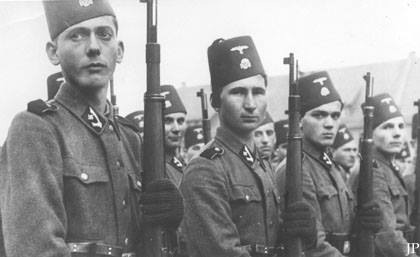The mountain infantry company of the ‘Handschar’ division on the parade ground.
Apart from the recruitment of ethnic Germans and ‘Germanic’ volunteers, from 1942 onwards Himmler began increasingly to recruit men who, in Nazi jargon, were termed ‘ethnic aliens’. As early as 1940 he had formed ‘legions’ in north-west Europe—with limited success, as we have seen— whose members did not have to meet the high ‘racial’ standards of the SS, and during the following years he engaged in massive recruitment in Wallonia and France. But if he was permitting men of ‘Roman’ or other non-Germanic origins to serve in the SS volunteer divisions then surely this practice could be expanded?
He embarked on one of the most audacious plans in this sphere in February 1943, after he had received Hitler’s approval for establishing a division of Bosnian Muslims along the lines of the Bosnian-Herzogovinan regiments of the Austrian empire.162 He met with opposition from the Croatian authorities, however. Furious, he told his representative in Croatia, Konstantin Kammerhofer, ‘to intervene using all your weight’. In the end the latter had the recruits conscripted on the basis of the general duty of military service. The men received their training in France and Silesia. Like their predecessors in the Austrian empire, the soldiers of the 13th SS Volunteer Mountain Division (Croatia) wore a red fez (in their combat uniforms it was grey) with a tassel and a badge which combined an eagle, the SS skull, and a swastika. Instead of the SS runes, on their right collar they wore a model of a ‘Handschar’, or scimitar. With reference to that, in May 1944 the division was renamed ‘Handschar’.
Himmler was quite prepared to respect the culture and way of life of his Islamic volunteers, and, as always when he was interested in something, got involved in details. He enquired of the Grand Mufti what Islamic food regulations should be adhered to as far as supplying the division was concerned, and then announced in August 1943 that he would grant to all ‘Islamic members of the SS and police [ . . . ] as an absolute special privilege [ . . . ] that, in accordance with their religious laws, they should never be served pork or sausage containing pork and should never be given alcohol to drink’. He should be informed of all contraventions of this order. And, ‘I also forbid any joking about these matters such as typically occurs among comrades or any “pulling the legs” of the Muslim volunteers’. He also concerned himself with practical questions: the new fezes of the division did not meet with his approval. He told Pohl that their colour had to be changed and they had to be slightly trimmed.
Himmler was not only prepared to allow the Grand Mufti to appoint several imams for his Bosnian division, he even aimed to allow members of the division to pursue Islamic studies; indeed, he went so far as to envisage establishing an ‘Islamic institute somewhere in Germany in which the Mufti can train imams so that he can have a corps of priests who are personally loyal to him and at the same time have been appropriately politically trained’. For after all, Islam and Nazism were linked by their common hostility to ‘the Jews’.
The Mufti of Jerusalem, Mohammad Amin al-Husayni, greeting members of the 13th SS Division with a Nazi salute in November 1943.
‘Why should anything come between Muslims in Europe and in the whole world and us Germans?’ he asked the 13th SS Mountain Division in a speech in January 1944:
We have the same aims. There can be no more solid a basis for living together than common aims and common ideals. For 200 years Germany has not had the slightest cause for friction with Islam [ . . . ] Now we Germans and you in this division, you Muslims, share a common feeling of gratitude that God—you call him Allah, but it’s the same—has sent our tormented European nations the Führer, the Führer who will rid first Europe and then the whole world of the Jews, these enemies of our Reich, who robbed us of victory in 1918 so that the sacrifice of two million dead was in vain. They are also your enemies, for the Jew has been your enemy from time immemorial.
Reading this speech, one might conclude that Himmler’s expression of respect for the world religion of Islam was genuine. In fact, however, his emphasis on common ideals was nothing more than cynical hypocrisy. Two weeks later Himmler reiterated to the Reich propaganda offices why he valued the Croatian volunteers so highly: ‘I must say I have nothing against Islam; for it preaches to its members in this division and promises them paradise if they have fought and died. A practical and agreeable religion for soldiers!’
In battle, however, the division disappointed his expectations. Deployed against partisans in their homeland at the end of 1943, the force proved relatively ineffective and, what is more, increasingly rebellious. At the end of 1944 Himmler ended the experiment. Two other Muslim units—the 21st SS Mountain Division ‘Skanderbeg’ composed of Albanians and a Croatian division named ‘Kama’—were also short-lived. Both had been established only in 1944. ‘Skanderbeg’ was dissolved in autumn 1944 and ‘Kama’ appears never to have been ready for combat. As a result, Himmler’s original plan of establishing two army corps of Bosnian and Albanian troops in the Balkans and, by the end of 1944, of combining them with the ‘Prince Eugene Division’ to form an autonomous SS army had failed.
Lepre, George (1997). Himmler’s Bosnian Division: The Waffen-SS Handschar Division 1943–1945. Atglen, Philadelphia: Schiffer Publishing. ISBN 0-7643-0134-9. This is the principal text in English on the subject, and has been cited by historians such as Mario Jareb and Charles L. Melson in scholarly texts and journals.
